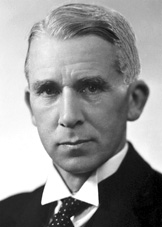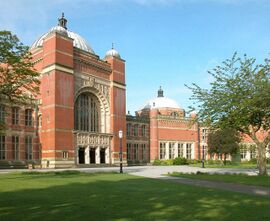والتر هاورث
والتر هاورث Walter Haworth | |
|---|---|
 Walter Haworth | |
| وُلِدَ | مارس 19, 1883 |
| توفي | مارس 19, 1950 (aged 67) |
| القومية | المملكة المتحدة |
| المدرسة الأم | جامعة مانشستر جامعة گوتنگن |
| عـُرِف بـ | أبحاث في كربوهيدرات وڤيتامين ج |
| الجوائز | وسام ديڤي (1934) جائزة نوبل في الكيمياء (1937) الوسام الملكي (1942) |
| السيرة العلمية | |
| المجالات | الكيمياء العضوية |
| الهيئات | جامعة سانت أندروز جامعة درم جامعة برمنگهام |
| المشرف على الدكتوراه | وليام هنري پركن، الابن, أوتو ڤلاخ |
السير والتر نورمان هاورث Walter Haworth FRS[1] (عاش 19 مارس 1883 - 19 مارس 1950) هو كيميائي بريطاني. عرف كثيرا بأعماله الرائدة حول حمض الأسكوربيك (ڤيتامين سي) أثناء عمله في جامعة برمنگهام. وقد حصل على جائزة نوبل في الكيمياء لعام 1937 "لأبحاثه في النشويات وڤيتامين سي". وقد تقاسم الجائزة مع الكيميائي السويسري پول كارر لعمله في ڤيتامينات أخرى.[2][3]
Haworth worked out the correct structure of a number of sugars, and is known among organic chemists for his development of the Haworth projection that translates three-dimensional sugar structures into convenient two-dimensional graphical form.
السيرة
درس الكيمياء في جامعة مانشستر رغم معارضة عائلته بعد أن عمل في مصنع والده. في سنة 1909 ذهب إلى جامعة گوتنگن حيث عمل في مختبر أوتو ڤالاخ حيث حصل على الدكتوراه سنة 1910 .
في سنة 1911 حصل على وظيفة في كلية امبريال وذهب سنة 1912 إلى سانت اندروز وعمل فيها محاضرا ثم انتقل إلى درهام سنة 1920 . في سنة 1925 أصبح بروفسورا في جامعة برمنگهام وبقي فيها حتى تقاعده في 1948.
حصل على جائزة نوبل في الكيمياء سنة 1937 وذلك لأعماله على فيتامين ج والنشويات متقاسما إياها مع پول كارر.
السيرة الأكاديمية
Having worked for some time from the age of fourteen in the local Ryland's linoleum factory managed by his father, he studied for and successfully passed the entrance examination to the University of Manchester in 1903 to study chemistry. He made this pursuit in spite of active discouragement by his parents. He gained his first-class honours degree in 1906. After gaining his master's degree under William Henry Perkin, Jr., he was awarded an 1851 Research Fellowship from the Royal Commission for the Exhibition of 1851[4] and studied at the University of Göttingen earning his PhD in Otto Wallach's laboratory after only one year of study. A DSc from the University of Manchester followed in 1911, after which he served a short time at the Imperial College of Science and Technology as Senior Demonstrator in Chemistry.
In 1912 Haworth became a lecturer at United College of University of St Andrews in Scotland and became interested in carbohydrate chemistry, which was being investigated at St Andrews by Thomas Purdie (1843–1916) and James Irvine (1877–1952). Haworth began his work on simple sugars in 1915 and developed a new method for the preparation of the methyl ethers of sugars using methyl sulfate and alkali (now called Haworth methylation). He then began studies on the structural features of the disaccharides. Haworth organised the laboratories at St Andrews University for the production of chemicals and drugs for the British government during World War I (1914–1918).
He was appointed Professor of Organic Chemistry at the Armstrong College (Newcastle upon Tyne) of Durham University in 1920. The next year Haworth was appointed Head of the Chemistry Department at the college. It was during his time in the North East of England that he married Violet Chilton Dobbie.

In 1925 he was appointed Mason Professor of Chemistry at the University of Birmingham (a position he held until 1948). Among his lasting contributions to science was the confirmation of a number of structures of optically active sugars: by 1928, he had deduced and confirmed, among others, the structures of maltose, cellobiose, lactose, gentiobiose, melibiose, gentianose, raffinose, as well as the glucoside ring tautomeric structure of aldose sugars. He published a classic text in 1929, The Constitution of Sugars.[5]
In 1933, working with the then Assistant Director of Research (later Sir) Edmund Hirst and a team led by post-doctoral student Maurice Stacey (who in 1956 rose to the same Mason Chair), having properly deduced the correct structure and optical-isomeric nature of vitamin C, Haworth reported the synthesis of the vitamin.[6] Haworth had been given his initial reference sample of "water-soluble vitamin C" or "hexuronic acid" (the previous name for the compound as extracted from natural products) by Hungarian physiologist Albert Szent-Györgyi, who had codiscovered its vitamin properties along with Charles Glen King, and had more recently discovered that it could be extracted in bulk from Hungarian paprika. In honour of the compound's antiscorbutic properties, Haworth and Szent-Györgyi now proposed the new name of "a-scorbic acid" for the molecule, with L-ascorbic acid as its formal chemical name. During World War II, he was a member of the MAUD Committee which oversaw research on the British atomic bomb project.[5]
Recognition
Haworth is commemorated at the University of Birmingham in the Haworth Building, which houses most of the University of Birmingham School of Chemistry. The School has a Haworth Chair of Chemistry, held by Professor Nigel Simpkins from 2007 until his retirement in 2017,[7] and by Professor Neil Champness since 2021.
In 1977 the Royal Mail issued a postage stamp (one of a series of four) featuring Haworth's achievement in synthesising vitamin C and his Nobel prize.[8]
He also developed a simple method of representing on paper the three-dimensional structure of sugars. The representation, using perspective, now known as a Haworth projection, is still widely used in biochemistry.[9]
الحياة الشخصية
In 1922 he married Violet Chilton Dobbie, daughter of Sir James Johnston Dobbie. They had two sons, James and David.[5]
He was elected a Fellow of the Royal Society (FRS) in 1928.
He was knighted in the 1947 New Years Honours List.
He died suddenly from a heart attack on 19 March 1950, his 67th birthday.[5]
المصادر
- ^ Hirst, E. L. (1951). "Walter Norman Haworth. 1883–1950". Obituary Notices of Fellows of the Royal Society. 7 (20): 372–404. doi:10.1098/rsbm.1951.0008. JSTOR 769026. PMID 14894345. S2CID 40701042.
- ^ Hirst, E. L. (1951). Walter Norman Haworth 1883-1950. Advances in Carbohydrate Chemistry. Vol. 6. pp. 1–9. doi:10.1016/S0096-5332(08)60061-2. ISBN 9780120072064. PMID 14894345.
- ^ Hirst, E. L. (1950). "Sir Norman Haworth". Nature. 165 (4198): 587. Bibcode:1950Natur.165..587H. doi:10.1038/165587a0. PMID 15416703.
- ^ 1851 Royal Commission Archives
- ^ أ ب ت ث خطأ استشهاد: وسم
<ref>غير صحيح؛ لا نص تم توفيره للمراجع المسماةODNB - ^ Davies, Michael B.; Austin, John; Partridge, David A. (1991), Vitamin C: Its Chemistry and Biochemistry, The Royal Society of Chemistry, p. 48, ISBN 0-85186-333-7
- ^ www.chem.bham.ac.uk/staff/Simpkins.shtml. Retrieved 2 October 2010
- ^ Kyle, Robert A.; Shampo, Marc A. (2002). "Stamp Vignette on Medical Science". Mayo Clinic Proceedings. 77: 108. doi:10.1016/S0025-6196(11)62323-9.
- ^ Garrett, R.; Grisham, C. M. (2005), Biochemistry (3rd ed.), Belmont, CA: Thomson Brooks/Cole, p. 207, ISBN 9780534410209
وصلات خارجية
- Short description is different from Wikidata
- مواليد 1883
- وفيات 1950
- خريجو جامعة گوتنگن
- كيميائيون إنگليز
- حائزو بجائزة نوبل في الكيمياء
- حائزو جائزة نوبل بريطانيون
- خريجو جامعة مانشستر
- زملاء الجمعية الملكية
- Academics of Imperial College London
- أكاديميو جامعة درم
- أشخاص اقترنوا بجامعة برمنگهام
- أكاديميو جامعة القديس أندروز
- أشخاص من تشورلي
- الحاصلون على لقب فارس
- حائزو الوسام الملكي
- جوائز نوبل في الكيمياء